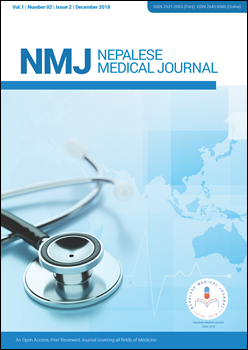Histopathological Evaluation of Skin Neoplasms
DOI:
https://doi.org/10.3126/nmj.v1i2.21591Keywords:
Glomus tumor, Melanoma, Nevus, Pilomatricoma, Sebaceoma, Squamous cell carcinomaAbstract
Introduction: Skin tumor incidence has increased over the last several decades. A wide range of tumors are encountered in clinical practice. Accurate identification of skin lesions is vital in ensuring malignancies are not missed and that they are treated early to avoid morbidity and mortality.
Materials and Methods: A retrospective cross sectional hospital based study on a series of cases was performed in the Department of Pathology, Patan Academy of Health Sciences, Patan Hospital, Lalitpur, Nepal from April 2011 to March 2016. Data from the histopathology database were analyzed using SPSS version 16.0.
Results: During the study period, 410 skin biopsies were received, of which 214 (52.2%) were skin neoplasms. Among them, 175 (81.8%) were benign and 39 (18.2%) were malignant neoplasms. Incidence of keratinocytic tumors was highest followed by soft tissue tumors and melanocytic tumors. Intradermal nevus was the most common benign neoplasm. Among the malignant neoplasms, squamous cell carcinoma was most prevalent (46.1%) followed by basal cell carcinoma (15.3%). Skin neoplasms were present in all age groups with maximum number of benign neoplasms prevalent in 21-30 years and malignant in 51-60 years age group. Mean age was 38 years and 58 years for benign and malignant neoplasms respectively.
Conclusions: Histopathological evaluation of skin biopsy is an important tool in diagnosis of skin neoplasms. Intradermal nevus and squamous cell carcinoma was the most common benign and malignant neoplasm respectively. Malignant neoplasms were more common in older patients.
Downloads
Downloads
Published
How to Cite
Issue
Section
License
This license enables reusers to distribute, remix, adapt, and build upon the material in any medium or format, so long as attribution is given to the creator. The license allows for commercial use.
Copyright on any article published by Nepalese Medical Journal is retained by the author(s).
Authors grant Nepalese Medical Journal a license to publish the article and identify itself as the original publisher.
Authors also grant any third party the right to use the article freely as long as its integrity is maintained and its original authors, citation details and publisher are identified.




